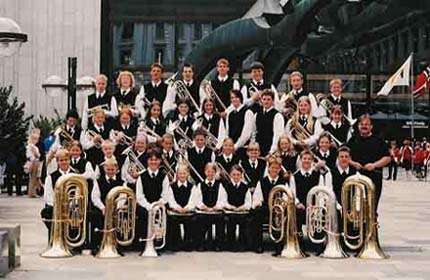Music Accelerates Neurodevelopment of Teen Minds, Says Study
 In teens, band practice enhances the brain’s ability to process sound better than ROTC training, says a new study in the Proceedings of the National Academies of Science.
In teens, band practice enhances the brain’s ability to process sound better than ROTC training, says a new study in the Proceedings of the National Academies of Science.
The study is getting “an ocean of responses,” along with another related study, senior author Nina Kraus told Bioscience Technology. Kraus is director of Northwestern University’s Auditory Neuroscience Laboratory. “One `first’” achieved by the study “is that in-school music lessons accelerate auditory neurodevelopment,” Kraus said. “We have been surprised to learn that through adolescence, ages 14 to 18, the brain continues to refine the way it processes sound. It suggests that enrichment allows the brain to capitalize on auditory experiences—such as music training—to speed up its own development.”
McGill University cognitive neuroscientist Robert Zatorre, Ph.D., said the study deserves the attention. “The group does a lot of excellent work, and here they have extended their studies to adolescents, which is novel,” he told Bioscience Technology. Zatorre was not involved in the work. “The study is valuable primarily in that it takes research out of the highly controlled but artificial laboratory setting, where most such studies are carried out, into `the wild’ where many more factors are at play, but where, ultimately, research has to go if it is to have any societal impact… The whole issue of musical training and the changes that it may engender in the brain is one that is of great current interest to many labs.”
 Distinguishing words better
Distinguishing words better
Kraus’s team followed 40 Chicago-area high school freshmen from freshman year until their senior year of high school. Approximately half spent two to three hours a week in band class. The remaining signed up with the junior Reserve Officers' Training Corps (ROTC), which involved extensive physical exercising. All the children attended the same low-income neighborhood schools.
Electrode recordings in the beginning, and the end, showed that the band kids’ brains demonstrated a more rapid maturation in response to sound. The band kids also demonstrated prolonged heightened brain sensitivity to sound details. All improved in sound-based skills key for language and reading, but the music group saw greater improvement. Abilities gained included the faster and more accurate distinguishing of words beginning with the same letter.
A key bottom line: music may offset the negative influence on sound processing, and learning, that is experienced by children in raised in poverty. The authors pointed out the results may be educational for school administrators, who tend to cut band class first at budget cut time.
The slow lilt of a sentence
“Sound is conveyed at once across many timescales—from the incredibly fast details of a single speech sound, to the slow lilt of a sentence,” Kraus told Bioscience Technology. “The brain is tuned into this timing information. What is striking is that we observed enhancements across the temporal board of sound processing.”
The Kraus lab’s past work includes studies finding that the brain waves elicited by sound are remarkably similar to those sound waves themselves. An example is found on their website, which Kraus calls “a labor of love.”
“Important finding”
Zatorre, who is co-director of Montreal’s International Laboratory for Brain, Music and Sound Research, covers similar musical ground. Last month he published a study pointing to the neurological correlates of talent in musical processing. (See upcoming Bioscience Technology story.)
The increase seen by Kraus’ band kids in "sound structure awareness," Zatorre said, “refers to a skill known as phonological awareness, something fairly commonly used in the linguistics and reading literature. It refers, roughly, to the ability to parse the sounds of speech. If someone is able to recognize that the word "Spot" and the word "Safe" both begin with the same sound, they are said to have phonological awareness. This ability (in a preschool kid for instance) is predictive of reading ability.”
The paper explains the tests thusly: “Phonological Awareness is a composite score made up of the elision subtest, in which participants are asked to create a new word by dropping a syllable or phoneme from a spoken word, and the blending words subtest, in which participants blend spoken syllables to create a new word.”
Zatorre said that, even though “one may point to some limitations in this study, the authors have done a good job of demonstrating an initial proof-of principle, allowing larger-scale, more detailed studies to be carried out in future. The research reflects a large investment of time (being a longitudinal study carried out over years), and effort (recruitment of adolescents in low-income neighborhoods). All of this should not be underestimated. A broader study would no doubt be important. But that would require much greater resources, which funding agencies would be unlikely to support without evidence from smaller-scale studies such as this to show that it’s worth pursuing.”
Another reason the study is of value, Zatorre said: “It measured both behavioral outcomes and brain responses. The results showed effects of musical training on both measures, although they were not found across the board. In terms of the neural outcomes, the principal effect has to do with the consistency of the brain’s response to sound. It declined in the control group, but stayed higher in the music training group. This is a factor which could be the explanation for why perception of sound might be enhanced after musical training, because it stands to reason that greater consistency of encoding sound in the nervous system would lead to a better capacity to use that sound, or to be sensitive to subtle aspects of the sound’s features.”
There was also a difference across groups in the amplitude of the cortical response to sound, Zatorre noted.
“The main behavioral finding is an enhancement in the ability to process speech sounds, known as phonological awareness, as measured from a composite score with various tests, which was greater for the music group than for the control group. Although the change across groups in enhancement of phonological awareness is modest in magnitude, and is also limited to this measure and not to other measures (memory and naming), it is still an important finding for the reasons noted above,” Zatorre said.
Limitations
Missing was, perhaps, stronger correlation proof. “I might have wanted to know whether there was a direct correlation between the neural changes, and the behavioral enhancements in this population,” Zatorre said. “As it stands, it's not certain the behavioral change was directly related to the neural changes, and if so which one—the consistency variable? The amplitude variable? Some other neural change affected by the musical training?”
Among other limitations: the fact that the ROTC control group “may not be a good match to the music training. It is difficult to know precisely what cognitive or other skills might be enhanced in the students who participated in this program.”
Likewise, Zatorre said, “as the authors acknowledge, the students were not assigned randomly to each group, considered the gold standard in longitudinal studies.” (Although, he added, this is “largely mitigated” by the fact that the two groups did not differ in any measures pre-training). But “here we come back to the difference in carrying out lab studies vs real-world studies. Those who clamor most about the limitations of non-random assignment and other such niceties are usually the ones who have never stuck their noses outside the lab. Random assignment is often nearly impossible in the real world for practical or even ethical reasons. This should not preclude ever doing any work outside a lab, or else we will never make progress in translating from one to the other.”


_itok-4tfCXO71.jpg)


